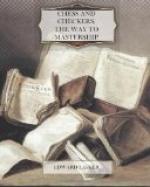II. ELEMENTARY TACTICS
III. The five fundamental positions
The first position
The second position
The change of the move
The third position
The fourth position
The fifth position
IV. General principles and illustrative games
V. PROBLEMS
INFORMATION ABOUT THIS E-TEXT EDITION
The following is an e-text of “Chess and Checkers: The Way to Mastership,” by Edward Lasker, copyright 1918, printed in New York.
This e-text contains the 118 chess and checkers board game diagrams appearing in the original book, plus an extra chess diagram that appears on the front cover of the book, all in the form of ASCII line drawings. The following is a key to the diagrams:
For chess pieces,
R = Rook
Kt = Knight
B = Bishop
Q = Queen
K = King
P = Pawn
Black pieces have a # symbol to the left of them, while white pieces have a ^ symbol to the left of them. For example, #B is the Black bishop, while ^B is the white bishop. #Kt is the black knight, while ^Kt is the white knight. This will let the reader instantly tell by sight which pieces in the ASCII chess diagrams are black and which are white.
For Checkers pieces,
* = black single piece
o = white single piece
** = black king
oo = white king
Those who find these diagrams hard to read should feel free to set up them up on a game board using the actual pieces.
PREFACE
The present world war has given great impetus to the game of Chess. In the prison camps, in the field hospitals, in the training camps and even in the trenches Chess has become a favorite occupation in hours of leisure, not only because it offers a most fascinating pastime, but mainly because it serves beyond any doubt to develop what is now the most interesting study for every soldier—the grasp of the principles underlying military strategy and the ability to conceive and to carry out military operations on a large scale.
Frederick the Great, Napoleon and Moltke, the great scientists of war, had a decided liking for the game of Chess and owed to it many an inspiration which helped them in laying out their military plans. Indeed, no other game exists which offers such complete analogies to war.
Two armies oppose each other on the Chess board, composed of different units which may well be compared with infantry, cavalry and artillery.
The success of the operations on the board, which represents the battlefield, does not depend upon any element of chance, but solely upon the ingenuity and the skill of the players who are the commanders-in-chief of the forces.




